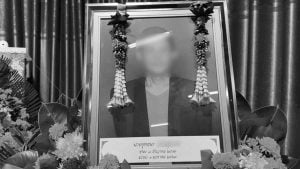Tsunami detection buoy coming soon: NDWC

PHUKET CITY: Phuket will get a new tsunami detection buoy just in time for the fifth anniversary of the 2004 tsunami disaster, the National Disaster Warning Center (NDWC) says.
Group Captain Somsak Khaosuwan, director of the NDWC’s warning system management team, told the Gazette the new buoy is being shipped to Thailand from the US and should arrive by the end of the month.
It will be deployed 600 nautical miles northwest of Phuket, replacing the buoy currently there, as part of a one-week mission that will depart from Cape Panwa on December 14.
The first buoy, deployed in December 2006, was donated to Thailand by the US government under an agreement that the NDWC would be responsible for its maintenance, including an annual battery change.
However, the NDWC never changed the battery and the unit finally fell silent in early September, far past its design capacity of just one year.
As a result, there are currently no operational direct detection buoys in the central Indian Ocean linked to the US government’s National Data Buoy Center and the NDWC must rely on seismic data alone when deciding whether to issue a warning.
Rather than change the battery at sea, the NDWC earlier this year decided to order a new DART II buoy from the US and replace the entire unit, retrieving the old unit for maintenance on land. The new unit is being funded by the NDWC.
The two units will be swapped with each other again next year as part of an annual maintenance regimen, Mr Somsak said.
Two more warning buoys that received funding approval for 165 million baht back in January 2008 have still not been acquired, but Mr Somsak said he is confident they will be deployed some time next year.
Mr Somsak blamed red tape for the delay.
The NDWC, initially under the Prime Minister’s Office, has been shifted to different ministries and departments so many times that it has never been able to get through the civil service procurement procedures before having to start again from scratch, he said.
This also explains why the agency’s 1860 hotline is currently inoperable, and why they don’t even have a website, he said.
The hotline will be fixed “soon” and a new, high-tech website is on the way that will allow numerous agencies to exchange information in real time about disaster warning and planning, he said.
The NDWC is also moving its headquarters from Nonthaburi to a new site on Bangna Trat Road in Bangkok, he said.
Mr Somsak was in Phuket late last week on a two-day inspection tour of all 19 warning towers in the province and to meet with officers at the Phuket Department of Disaster Prevention and Mitigation (DDPM-Phuket).
The NDWC is working on expanding the tsunami warning coverage in risk areas by setting up small new towers capable of carrying voice recorded alerts, he said.
The Gazette also spoke with former NDWC Director Dr Smith Dharmasaroja, who said he resigned his job with the agency almost two years ago to protest its failure to properly maintain the buoy.
This failure has put people at risk, not only in Thailand but all around the Indian Ocean Basin, he said.
Politics were behind his removal from the top post at the NDWC, he maintains.
“The people there will suffer if anything happens with no warning in the future. I am very mad at them because I set up a good plan, a good system. But this government told me ‘I am a Thaksin man,’ so they don’t like it and want to put their friend in my job,” he said.
Dr Smith said he expected that only about 5% to 10% of the 200 solar-powered tsunami warning towers in the Andaman region were still operational.
Mr Somsak strongly refuted this allegation, saying that his tour of Phuket revealed all 19 towers here were working normally, and that all 200 towers along the Andaman coastline are tested twice daily via satellite.
— Stephen Michael Fein
Latest Thailand News
Follow The Thaiger on Google News:


























